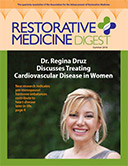Along with exercise, diet is one of the most extensively studied components of lifestyle interventions for preventing and managing cardiometabolic diseases (CMDs). Plant-based diets such as the Mediterranean diet and DASH (Dietary Approaches to Stop Hypertension) have been shown to be cardioprotective. Cardioprotective diets emphasize abundant fruits, vegetables, and legumes, as well as whole grains and lean protein. In addition, these diets minimize or exclude trans-fats, processed foods, and simple sugars.1,2,3 Nutrients and other bioactive compounds from the diet can have a significant effect on the pathological processes that underlie CMDs through a number of mechanisms, including those that involve oxidative stress, inflammation, endothelial function, and lipid metabolism.4,5 Diet also affects gene expression and can directly influence epigenetic states that lead to phenotypes with the potential for increased or decreased susceptibility to developing certain health conditions.6,7
Given the profound impact both that diet has on the gut microbiome and that the microbiome has on overall health, it is not surprising that the relationship between the microbiome and risk factors for developing CMDs is a growing area of research.8,9 Initially, this research focused on inflammation because of the significant role the microbiome plays in immune function,10 and because inflammation is a common factor among CMDs.11 An emerging direction of research, however, focuses on the gut microbiome as a complex, metabolically active system whose metabolites can impact the development of CMDs by directly influencing the phenotype of the host.12
It is now known that dysbiosis, or derangement in the composition and function of the gut microbiome, is associated with the development of cardiometabolic disorders through direct influence on epigenetic mechanisms like DNA methylation, posttranscriptional histone modification, and regulation by noncoding RNAs. An imbalance in gut microbiome metabolites, such as short-chain fatty acids13and trimethylamine-N-oxide14 (a pro-atherosclerotic metabolite from phosphatidylcholine found in red meat, poultry, and fish), can induce epigenetic changes that have been shown to strongly correlate with the development of obesity and diabetes,15 and contribute to outcomes such as coronary artery disease and heart failure.16
Advances in metagenomics and metabolomics have shown, for example, that changes in the ratio of Firmicutes to Bacteroidetes and the subsequent imbalance in gut microbial metabolite levels, have a strong correlation with the pathogenesis of CMDs.17 In addition, alterations in gut microbiome composition, specifically a deficit in Eubacterium and Prevotella, which are crucial for the biosynthesis of amino acids, was noted in people with heart failure.18,19,20
Numerous studies continue to demonstrate an association between gut microbial factors, CMD pathogenesis, and cardiovascular outcomes, but it is not yet known if this relationship is causal. Advances in our understanding of metabolomics and epigenetics should further elucidate the interplay of the heart-gut axis and susceptibility to cardiometabolic disorders, thereby paving the way for more personalized dietary and other lifestyle recommendations in the prevention and treatment of cardiovascular diseases.
References
- https://www.ncbi.nlm.nih.gov/pmc/articles/PMC10128075/
- https://www.nature.com/articles/s41430-021-01023-z
- https://www.mdpi.com/2072-6643/15/4/861
- https://www.mdpi.com/2072-6643/15/1/76
- https://www.tandfonline.com/doi/full/10.1080/10408398.2021.1943646
- https://www.nature.com/articles/s41467-018-05778-1
- https://www.ahajournals.org/doi/full/10.1161/HCG.0000000000000030
- https://www.ncbi.nlm.nih.gov/pmc/articles/PMC7416843/
- https://www.ncbi.nlm.nih.gov/pmc/articles/PMC7146472/
- https://www.nature.com/articles/s41684-018-0129-1
- https://www.nature.com/articles/s41422-020-0332-7
- https://www.ahajournals.org/doi/10.1161/CIRCRESAHA.123.322135
- https://pubmed.ncbi.nlm.nih.gov/32219347/
- https://www.ncbi.nlm.nih.gov/pmc/articles/PMC4453578/
- https://www.ncbi.nlm.nih.gov/pmc/articles/PMC6974692/
- https://pubmed.ncbi.nlm.nih.gov/23212374/
- https://www.ncbi.nlm.nih.gov/pmc/articles/PMC10435824/
- https://www.ncbi.nlm.nih.gov/pmc/articles/PMC10014482/
- https://pubmed.ncbi.nlm.nih.gov/34912870/
- https://www.ncbi.nlm.nih.gov/pmc/articles/PMC10136760/
